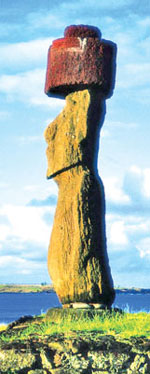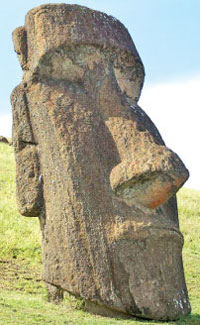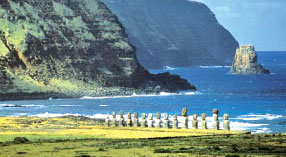Easter Island - It’s the world’s most
remote inhabited island
Home of the
moais
Last Sunday was a day of religious significance because Easter, which
commemorates the Resurrection of Jesus, the spiritual leader of millions
of Christians and
 Catholics
was celebrated the world over. The name Easter brings to mind an island
which bears the same name and we thought of enlightening you about this
little treeless island of volcanic origin which has great significance. Catholics
was celebrated the world over. The name Easter brings to mind an island
which bears the same name and we thought of enlightening you about this
little treeless island of volcanic origin which has great significance.
It was on Easter Sunday way back in 1722 that a Dutch explorer named
Jacob Roggeveen, who was searching for another island called Davis or
David's island in the Pacific Ocean came across Easter Island located in
the Pacific Ocean at 27 degrees south of the equator and some 2200 miles
(3600 kilometers) off the coast of Chile.He was the first recorded
European visitor and he decided to name this land Paasch-Eyland which is
18th century Dutch for "Easter Island. Isla de Pascua, the island's
official Spanish name, also means "Easter Island".

This Polynesian island in the southeastern Pacific Ocean, at the
southeastern most point of the Polynesian triangle was annexed as a
special territory of Chile in 1888.It is a World Heritage Site (as
determined by UNESCO) with much of the island protected within the Rapa
Nui National Park.
The present Polynesian name of the island, Rapa Nui or "Big Rapa,"is
said to have been coined after the slave raids of the early 1860s,
because of the island's geographic resemblance to the island of Rapa in
the Bass Islands of the Austral Islands group. However, there are
different views about the "original" Polynesian name for Easter Island.
Would you believe that the island is approximately 24.6 km (15.3 m)
long and 12.3 km (7.6 m) at its widest point? Easter Island is a
volcanic high island,consisting mainly of three extinct coalesced
volcanoes: Terevaka (altitude 507 meters) forms the bulk of the island.
Two other volcanoes, Poike and Rano Kau, form the eastern and southern
headlands and give the island its roughly triangular shape. It has an
area of 163.6 square kilometres (63.2 sq mi), and a maximum altitude of
507 metres (1,663 ft). There are only three freshwater crater lakes in
the island and they are at Rano Kau, Rano Raraku and Rano Aroi, near the
summit of Terevaka. There are no permanent streams or rivers in the
island.
Today this island which is one of the most remote inhabited islands
in the world, is famous for the world over for its 887 monuments known,
as "moai". Created by the early Rapa Nui people who lived in the island
these unusual volcanic carvings are considered to be some of the most
incredible ancient relics ever discovered.
There is on going research to ascertain as to when the island was
initially inhabited, but some experts claim it could have taken place
from around 300-400 CE,to much later.
 The
massive moai statues, which are famous today are the most visible
element in the culture. They represent deified ancestors. It was
believed that the living had a symbiotic relationship with the dead
where the dead provided everything that the living needed (health,
fertility of land and animals,and fortune) and the living through
offerings provided the dead with a better place in the spirit world. The
massive moai statues, which are famous today are the most visible
element in the culture. They represent deified ancestors. It was
believed that the living had a symbiotic relationship with the dead
where the dead provided everything that the living needed (health,
fertility of land and animals,and fortune) and the living through
offerings provided the dead with a better place in the spirit world.
As most settlements were located on the coast the moai were erected
all along the coastline to watch over their descendants in the
settlements before them, with their backs toward the spirit world in the
sea.At least 288 of these enormous stone statues once stood upon massive
stone platforms called ahu. There are some 250 of these ahu platforms
today spaced out about half a mile apart, and creating an almost
unbroken line around the perimeter of the island. Another 600 moai
statues, which are in various stages of completion can also be seen
scattered around the island, either in quarries or along ancient roads
between the quarries and the coastal areas where the statues were most
often erected. It has been discovered that nearly all the moai are
carved from the tough stone of the Rano Raraku volcano.Most of these
statues are twice the size of the tallest human on the Earth, with the
average height recorded as 14 feet, 6 inches. They are not lightweight
either, as research has revealed that each weigh around 14 tones. Some
moai are said to be as large as 33 feet and weighing more than 80 tons.
One statue which is only partially quarried from the bedrock had
measured 65 feet in length and researchers say it would have weighed an
estimated 270 tons once completed. Going by the size of these statues,
it has been estimated that between 50 and 150 people would have been
needed to drag them across the countryside on sleds and rollers made
from the island's trees. However not all the statues had been moved to
ceremonial sites.
Fewer than one-fifth of them had been moved and erected once they had
red stone cylinders (pukau) placed on their heads. These red stone
cylinders are popularly called "topknots",and are believed to have been
carved in a single quarry known as Puna Pau.

About 95 per cent of the 887 moai known to date have been carved out
of compressed volcanic ash at Rano Raraku, where 394 moai still remain
visible today. Recent mapping in the interior may add additional moai to
that count.
Today, about 50 moai have been re-erected on their ceremonial sites.
Mystery still surrounds the purpose of the ahu platforms and moai
statues with so many theories being put forward by researchers and
archaeologists.
Fast facts
* Sixty-three square miles in size and with three extinct volcanoes
(the tallest rising to 1674 feet), the island is, technically speaking,
a single massive volcano rising over ten thousand feet from the Pacific
Ocean floor.
* The closest inhabited neighbour to Easter Island is Pitcairn
Island, 2,075 km (1,289.35 mi) to the west, with fewer than a hundred
inhabitants. Isla Salas Gomez, 415 km (258 mi) to the east, is closer
but is uninhabited.
* The Easter Island has a subtropical maritime climate and records
its lowest temperatures in July and August.
* Easter Island's isolated location exposes it to winds which help to
keep the temperature.
* Easter Island and surrounding islets such as Motu Nui, Motu Iti
form the summit of a large volcanic mountain rising over 2,000 metres
(1.2 mi) from the sea bed.
* Its inhabitants have endured famines, epidemics, civil war, slave
raids, colonialism, and near deforestation; its population declined
precipitously more than once.
* It is believed that the island was most probably populated by
Polynesians who navigated in canoes or catamarans from the Marquesas
Islands, 3,200 km (2,000 mi) away, or the Gambier Islands (Mangareva,
2,600 km (1,600 mi) away)
* The first recorded European contact with the island was on April 5
(Easter Sunday), 1722, when Dutch navigator Jacob Roggeveen visited the
island for a week and estimated a population of 2,000 to 3,000
inhabitants.
* Research has revealed that the island was formerly forested, with a
range of trees, shrubs, ferns, and grasses. A large, extinct palm,
Paschalococos disperta, related to the Chilean wine palm (Jubaea
chilensis), was one of the dominant trees as attested by fossil
evidence. Like its Chilean counterpart it probably took close to 100
years to reach adult height.
* The oldest known traditional name of the island is Te Pito o Te
Henua, meaning 'The Center (or Navel) of the World.' In the 1860's
Tahitian sailors gave the island the name Rapa Nui, meaning 'Great Rapa,'
due to its resemblance to another island in Polynesia called Rapa Iti,
meaning 'Little Rapa.'
* Although the moai statues are usually identified as "heads" only,
they are actually heads and truncated torsos.
* The statues were carved by the Polynesian colonizers of the island
beginning by about A.D. 1000 - 1100. In addition to representing
deceased ancestors, the moai, once they were erect on ceremonial sites,
may also have been regarded as the embodiment of powerful living chiefs.
Facts and pix: Internet |

